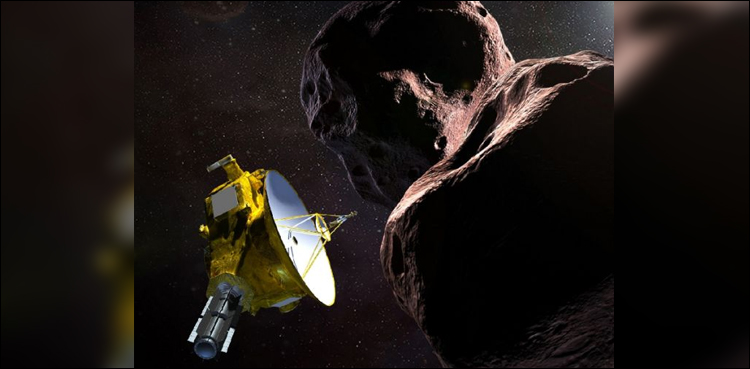
TAMPA: NASA rang in the New Year on Tuesday with a historic flyby of the farthest, and quite possibly the oldest, cosmic body ever explored by humankind — a tiny, distant world called Ultima Thule — in the hopes of learning more about how planets took shape.
A series of anxiously awaited “phone home” signals arrived after 10:30 am (1530 GMT), indicating that the spacecraft had made it, intact, through the risky, high-speed encounter.
“We have a healthy spacecraft,” said mission operations manager Alice Bowman, as cheers erupted in the control rooms at Johns Hopkins Applied Physics Laboratory in Maryland.
About 10 hours earlier, NASA celebrated the New Year’s flyby, as mission managers — alongside kids dressed in space costumes — blew party horns to mark the moment at 12:33 am (0533 GMT) when the New Horizons spacecraft aimed its cameras at the space rock four billion miles (6.4 billion kilometers) away in a dark and frigid region of space known as the Kuiper Belt.

More images and data will start arriving later Tuesday, offering scientists the first up-close look at an ancient building block of planets, Bowman said.
The flyby took place about a billion miles beyond Pluto, which was until now the most faraway world ever visited up close by a spacecraft.
Hurtling through space at a speed of 32,000 miles per hour, the spacecraft made its closest approach within 2,200 miles of the surface of Ultima Thule.
“This is a night none of us are going to forget,” said Queen guitarist Brian May — who also holds an advanced degree in astrophysics — and who recorded a solo track to honor the spacecraft and its spirit of exploration.
Lead planetary scientist for New Horizons, Alan Stern, said Ultima Thule is unique because it is a relic from the early days of the solar system and could provide answers about the origins of other planets.
“The object is in such a deep freeze that it is perfectly preserved from its original formation,” he said.
“Everything we are going to learn about Ultima — from its composition to its geology to how it was originally assembled, whether it has satellites and an atmosphere and those kinds of things — are going to teach us about the original formation conditions of objects in the solar system.”
Coming into focus
Scientists are not sure exactly what Ultima Thule (pronounced TOO-lee) looks like — whether it is cratered or smooth, or even if it is a single object or a cluster.
But a new, though still blurry image released Tuesday showed its oblong shape resembles something like a bowling pin or a peanut, and its dimensions are about 22 miles long and nine miles wide (35 by 15 kilometers).
Stern said his bet is that the object is a single body, not two pieces orbiting each other, but he would wait until more, clearer images arrive Wednesday to say for sure.
The highest resolution images are expected in February, Stern said.
Ultima Thule was discovered in 2014 with the help of the Hubble Space Telescope.
Scientists decided to study Ultima Thule with New Horizons after the spaceship, which launched in 2006, completed its main mission of flying by Pluto in 2015, returning the most detailed images ever taken of the dwarf planet.
Stern said the goal was to take images of Ultima that are three times the resolution the team had for Pluto.
Frontier of planetary science
Ultima Thule is named for a mythical, far-northern island in medieval literature and cartography, according to NASA.
Project scientist Hal Weaver of the Johns Hopkins Applied Physics Laboratory said humans didn’t even know the Kuiper Belt — a vast ring of relics from the formation days of the solar system — existed until the 1990s.
“This is the frontier of planetary science,” said Weaver.
Another NASA spacecraft, OSIRIS-REx, also set a new record on Monday by entering orbit around the asteroid Bennu, the smallest cosmic object — about 1,600 feet (500 meters) in diameter — ever circled by a spacecraft.
NASA said the orbit some 70 million miles (110 million kilometers) away marks “a leap for humankind” because no spacecraft has ever “circled so close to such a small space object — one with barely enough gravity to keep a vehicle in a stable orbit.”
The twin planetary feats coincided with the 50th anniversary of the first time humans ever explored another world, when US astronauts orbited the Moon aboard Apollo 8 in December, 1968.
“As you celebrate New Year’s Day, cast an eye upward and think for a moment about the amazing things our country and our species can do when we set our minds to it,” Stern wrote in the New York Times on Monday.
The post ‘We have a healthy spacecraft’: NASA succeeds in historic flyby of faraway world appeared first on ARYNEWS.
from ScienceTechnology – ARYNEWS http://bit.ly/2F0ZgaL
